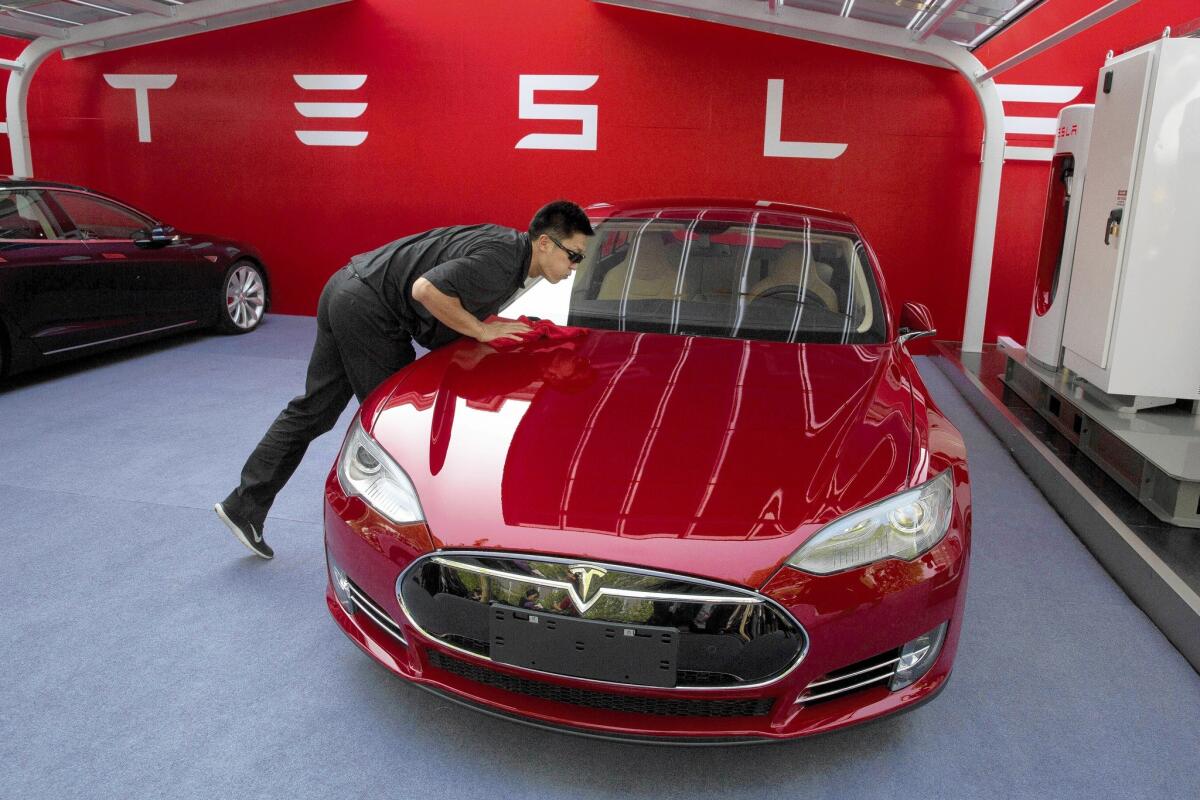Tesla announces plan to boost production in 2015

- Share via
Tesla Motors Inc. Chief Executive Elon Musk promised shareholders a dramatic boost in the production of his company’s electric cars, telling investors that Tesla will produce 35,000 cars this year and will have the capacity to produce up to 100,000 in 2015.
FOR THE RECORD:
Tesla earnings: An article in the Aug. 1 Business section about Tesla’s earnings report stated that the automaker could produce as many as 100,000 electric cars in 2015. In fact, the company said it will be producing cars at an annualized rate of 100,000 per year by the end of 2015. —
Tesla, which reported earnings Thursday, also confirmed that the company has begun construction in Reno, Nev., on the first of possibly several battery factories. That news came hours after Tesla announced that it had entered into a long-term partnership with Panasonic Corp. to produce the vehicles’ lithium-ion batteries.
The $5-billion cost of multiple “gigafactory” locations would be shared by Panasonic, which would be expected to match Tesla’s 40% commitment, with an additional 20% commitment coming from other investors and contributions from governments where the factories will be built.
Earlier reports had said Panasonic could invest between $200 million and $1 billion in the massive facility.
Tesla had said recently that California — where the Palo Alto company started and builds all of its automobiles and components — was competing with Nevada, Arizona, New Mexico and Texas for the right to host the factory. As many as 6,500 workers could be employed in the battery plant or plants.
On a call with investors and analysts, Musk said Tesla would eventually be able to make as many as 300,000 cars annually — and at a 30% cost reduction — once it fully ramps up battery production.
That will be necessary for the company to grow, analysts said. The company’s Model S sedan has a starting MSRP of $71,000, and can sell for more than $100,000 with options. The anticipated Model X sport utility vehicles, which will be available to customers in the spring of 2015, is expected to sell in the same range.
But the company’s longer-term hopes are pinned on the Tesla Model 3, a mass-market model that could sell for as low as $35,000. The mainstream model may be key to the company’s ongoing success and its continued push into new markets such as China and Britain.
Musk said he believed that the Asia-Pacific region — including new territories Australia, New Zealand, Japan and Korea — would ultimately account for 40% of Tesla sales, with North America accounting for the same amount and Europe about 20%.
In its earnings report, Tesla said it had revenue of $769 million for the quarter, using generally accepted accounting principles, including $23 million from sales of power-train components to Mercedes-Benz and Toyota, which are using Tesla parts to build electric cars.
Income for the quarter showed a loss of $62 million, or 50 cents a share.
The company said it would increase investment by $750 million to $950 million in 2015, up from earlier estimates.
Analysts were pleased with the numbers.
“Tesla is the only game in town for electric vehicles in this class and with this kind of range,” said Thilo Koslowski, senior automotive analyst for the firm Gartner. “They are not going to face any kind of competition anytime soon.”
Tesla already uses Panasonic’s lithium-ion battery cells, produced in Japan, for its California-made electric automobiles. Under the terms of the new partnership, jointly announced in Palo Alto and Osaka, Japan, Tesla will supply the factory and Panasonic will build the cells at the new facility.
The deal encouraged analysts.
“Panasonic is hands-down the world’s best manufacturer of lithium-ion batteries,” said Craig Irwin of WedBush Securities. “Tesla is young in its capabilities around these batteries. Having Panasonic in the partnership raises my confidence.”
The electric car maker reported earnings using a different accounting method that it says better reflects its financial position by booking revenue more quickly. That method showed revenue for the quarter increasing 55%, to $858 million. Income for the quarter, the company said, was $16 million, or 11 cents a share.
Tesla stock closed down $5.62, or 2.5%, at $223.30.
Musk declined to say what other locations might have an advantage in landing additional battery factories. Previously he had stated that California was “a long shot.” But according to Rhys Williams, spokesman for California Senate leader Darrell Steinberg (D-Sacramento), a conversation between state officials and Tesla is ongoing and active.
Legislation known as SB1309 is being drafted to address issues of streamlining red tape and creating financial incentives, designed to convince Tesla to expand manufacturing in the state, Williams said.







